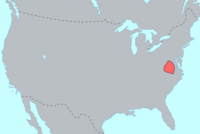Tutelo language facts for kids
Quick facts for kids Tutelo |
|
|---|---|
| Tutelo-Saponi | |

Tutelo language region prior to European colonization.
|
|
| Native to | United States |
| Region | Virginia, West Virginia, Ohio, Pennsylvania, New York, North Carolina |
| Ethnicity | Tutelo, Saponi, Occaneechi, Manahoac, Monacan |
| Extinct | after 1982 with the death of Albert Green |
| Language family |
Siouan
|
| Linguist List | tta |
The Tutelo language, also known as Tutelo-Saponi, is an old language from the Siouan family. It was first spoken in what is now Virginia and West Virginia in the United States. Over time, some Tutelo speakers moved north to avoid wars. They traveled through North Carolina, Pennsylvania, and New York. After the American Revolutionary War, they settled in Ontario, Canada. There, they joined the Cayuga (who spoke an Iroquoian language) at a place now called Six Nations of the Grand River First Nation.
Nikonha was the last person who spoke Tutelo fluently in its original homeland. He passed away in 1871 when he was 106 years old. The year before, he shared about 100 words with Horatio Hale, a language expert who visited him. In 1753, the Tutelo people had joined the Iroquois group with help from the Cayuga. People living at Grand River continued to speak Tutelo well into the 1900s. Many scholars like J. N. B. Hewitt, James Owen Dorsey, Leo J. Frachtenberg, Edward Sapir, Frank Speck, and Marianne Mithun recorded the language. Sadly, the last active speakers, a mother and daughter, died in a fire just before Mithun's visit in 1982. The very last native speaker, Albert Green, died sometime after that.
Recording the Tutelo Language
Horatio Hale published a short grammar book and a list of words in 1883. He confirmed that Tutelo was a Siouan language by comparing it to Dakota and Hidatsa. He was very excited to find an ancient Siouan language. This language was once common among tribes in Virginia. It had been kept alive on a reserve in Ontario, where most people spoke Iroquoian languages.
Before Hale's work, there was little information about Tutelo. A short list of words was collected by Lieutenant John Fontaine in 1716 at Fort Christanna. A few other words were recorded by early settlers like John Lederer and William Byrd II.
Hale also noted that the dialect of the Occaneechi people was very important. This language was thought to be similar to Tutelo. It was used as a lingua franca (a common language) by all the tribes in the area. Chiefs, "conjurers" (spiritual leaders), and priests of all tribes knew it. These spiritual leaders used it in their ceremonies. Hale even compared Tutelo's rich verb tenses to those in Latin and Ancient Greek.
James Dorsey, another Siouan language expert, collected many words and grammar examples around the same time as Hale. J. N. B. Hewitt did similar work a few years later. Frachtenberg and Sapir visited the Six Nations reserve in Ontario in the early 1900s. They found that only a few Cayuga people with Tutelo ancestors remembered a few Tutelo words. Frank Speck worked hard in the 1930s to record and save their cultural traditions. However, he found very little of the language left. Marianne Mithun managed to collect a few terms that people still remembered in 1980.
Experts now believe that the Tutelo language, as recorded, was very similar to other Virginia Siouan languages. This includes the languages of the Monacan, Manahoac, and Nahyssan groups. It also includes the languages of the Occaneechi and Saponi.
Bringing the Language Back
In the 21st century, descendants of these original groups are interested in bringing the language back. This is called language revitalization. In 2021, the Living Tongues Institute for Endangered Languages helped Tutelo activists. They worked together to create a "Living Dictionary" for Tutelo-Saponi Monacan. This project helps people learn and use the language again.
Images for kids


